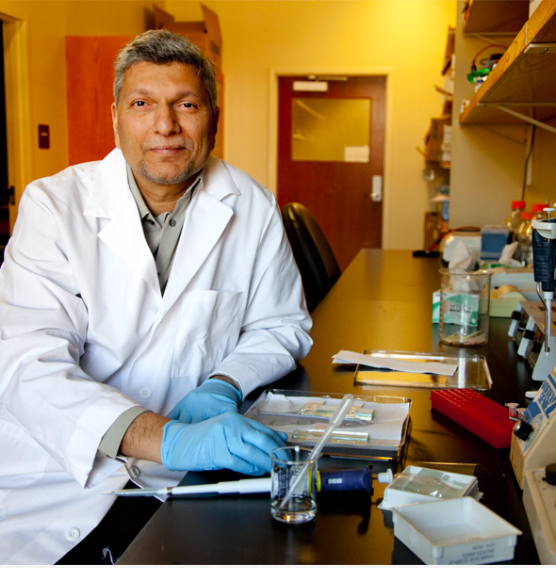

Research Terms
Keywords
Behavioral neuroscience Developmental cognitive neuroscience Pediatric Rare Diseases Rare disease
Industries
ZRG1 EMNR-R 55, NIH; 2012 - 2012
Research Grants, Autism Speaks; 2011 - 2011
VA Center of Excellence, VA; 2009 - 2009
NIH-Neurogenesis and Cell Fate, NIH; 2008 - 2012
NINDS-NSD-B (NINDS Program Projects), NIH; 2006 - 2006
ZNS1-SRB-M34 (NINDs Fellowships), NIH; 2006 - 2007
Scientific Advisory Board, National Parkinsons Foundation; 2006 - 2008
ZNS1-SRB-E (NINDS Program Projects), NIH; 2005 - 2006
Brain Development and Clinical Neuroscience - 2, NIH; 2003 - 2004
Brain Development and Clinical Neuroscience - 4, NIH; 2003 - 2004
Molecular Develeopmental Cellular Neuroscience, NIH; 1999 - 1999
Florida Institute for Pediatric Rare Diseases
| Director |
Pradeep Bhide |
| Phone | 850/645-9847 |
| Website | https://med.fsu.edu/iprd/home |
| Mission | Our mission is research, discovery, education and community outreach in the areas of prevention, amelioration, treatment, and repair of injuries or damage to the brain and spinal cord resulting from trauma, genetic and degenerative diseases, cardiovascular anomalies including stroke, drug abuse, environmental toxins, and other causes. |
Institute for Pediatric Rare Diseases
| Director |
Pradeep Bhide |
| Phone | |
| Website | https://med.fsu.edu/iprd/home |
| Mission | The Institute for Pediatric Rare Diseases (IPRD) takes a comprehensive and strategic approach for developing innovative technologies for the diagnosis and treatment of a broad range of rare diseases. The Institute’s programs include a pediatric health center, genomics research and diagnostic services, graduate program in genetic counseling and rare disease research initiatives. Its multidisciplinary team of clinicians and scientists strives to develop innovative solutions for the treatment and management of rare diseases through research, advocacy, public outreach and training the next generation of physicians, scientists, genetic counselors and other healthcare professionals. |
Cognitive flexibility is the ability to execute multiple mental tasks simultaneously, to switch from one task to the next easily, and to restructure knowledge and strategy to tackle changing tasks. Deficits in cognitive flexibility are associated with multiple psychiatric conditions including schizophrenia, autism spectrum disorder and ADHD. Despite its critical role in normal mental function, and despite its well documented associated impairment, drugs that selectively target and improve cognitive flexibility are not available.
The present technology shows that excess brain derived growth factor (BDGF) is associated with deficits in cognitive flexibility and that ANA-12 is an effective treatment for cognitive ability.
Dopamine is a critical regulator of working memory, a mechanism for short-term information storage. Deficits in working memory occur in diseases with dopamine imbalance such as ADHD, schizophrenia and Parkinson’s Disease. However, a targeted treatment for working memory deficits is not available. In rodent models with working memory deficits, we show that selective activation of the dopamine D4 receptor (D4R) improves working memory. Based on these findings we propose that drugs that selectively activate the D4 receptor are novel class drugs for the treatment for working memory deficits.
D4R is found in abundance in the frontal cortex and hippocampus, brain regions that regulate working memory function. We examined two rodent models with working memory deficits, a prenatal nicotine exposure mouse model and the spontaneously hypertensive rat model. In both the models, activity and expression of the D4R are significantly decreased in the frontal cortex. Although dopamine D2 receptors expression and activity are also decreased in the frontal cortex of these models, improvements in working memory produced by psycho-stimulant administration were accompanied by increases in the activity of only the D4R and not the D2 receptor. Therefore, it can be concluded that selective increase in frontal cortical D4R activity is associated with improvement of deficient working memory.
Dopaminergic drugs that activate or antagonize multiple dopaminergic receptors or that produce global increases in brain dopamine content have failed as effective treatments for working memory deficits because of their pleotropic actions. Our discovery suggests that drugs that selectively target the D4 receptor and improve its function are effective treatments for working memory deficits.







































































